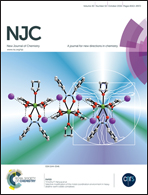Synthesis of a dual pH and temperature responsive star triblock copolymer based on β-cyclodextrins for controlled intracellular doxorubicin delivery release
Abstract
Well-defined dual pH and temperature responsive triblock star-shaped amphiphilic copolymers of β-cyclodextrin-g-poly(2-hydroxyethylmethacrylate)-b-poly(N-isopropylacrylamide)-b-poly(2-(dimethylamino)ethylmethacrylate) (β-CD-g-(PHEMA-b-PNIPAM-b-PDMAEMA)) were synthesized by the combination of reversible addition–fragmentation chain transfer (RAFT) polymerizations. The chemical structures and compositions of these copolymers were characterized by Fourier transform infrared spectroscopy (FTIR), proton nuclear magnetic resonance (1H NMR), and gel permeation chromatography (GPC) measurements. Subsequently, the obtained triblock copolymers could self-assemble into micelles in aqueous solution owing to their amphiphilic property resulting from the hydrophobic β-CD core and the hydrophilic PHEMA, PNIPAM, and PDMAEMA segments, which were investigated by dynamic light scattering (DLS) and transmission electron microscopy (TEM). The triblock copolymer nanoparticles exhibited two separate lower critical solution temperatures (LCSTs) and these triblock copolymers in aqueous solutions were investigated at the different pH values of 5.0 and 7.4 as doxorubicin (DOX) delivery systems for controlled release. Polymeric micelles exhibited a pH controlled release performance. Investigation of DOX release from the micelles indicated that the release rate of the drug could be effectively controlled by altering the pH, encapsulating DOX in neutral surroundings (blood circulation or extracellular matrix) and triggering DOX release in acidic surroundings (intracellular endosomes). CCK-8 assays and confocal laser scanning microscopy (CLSM) against HeLa cells indicated that the polymeric micelles themselves had no associated cytotoxicity and possessed good biodegradability and biocompatibility and that the micelles identified the location of the DOX in the HeLa cells. On the other hand, the DOX-loaded micelles possessed a high cytotoxicity to HeLa cells and exhibited inhibition of the proliferation of HeLa cells. Hence, this type of biodegradable, biocompatible, and stimuli-responsive copolymer could serve as a promising material for drug delivery.


 Please wait while we load your content...
Please wait while we load your content...